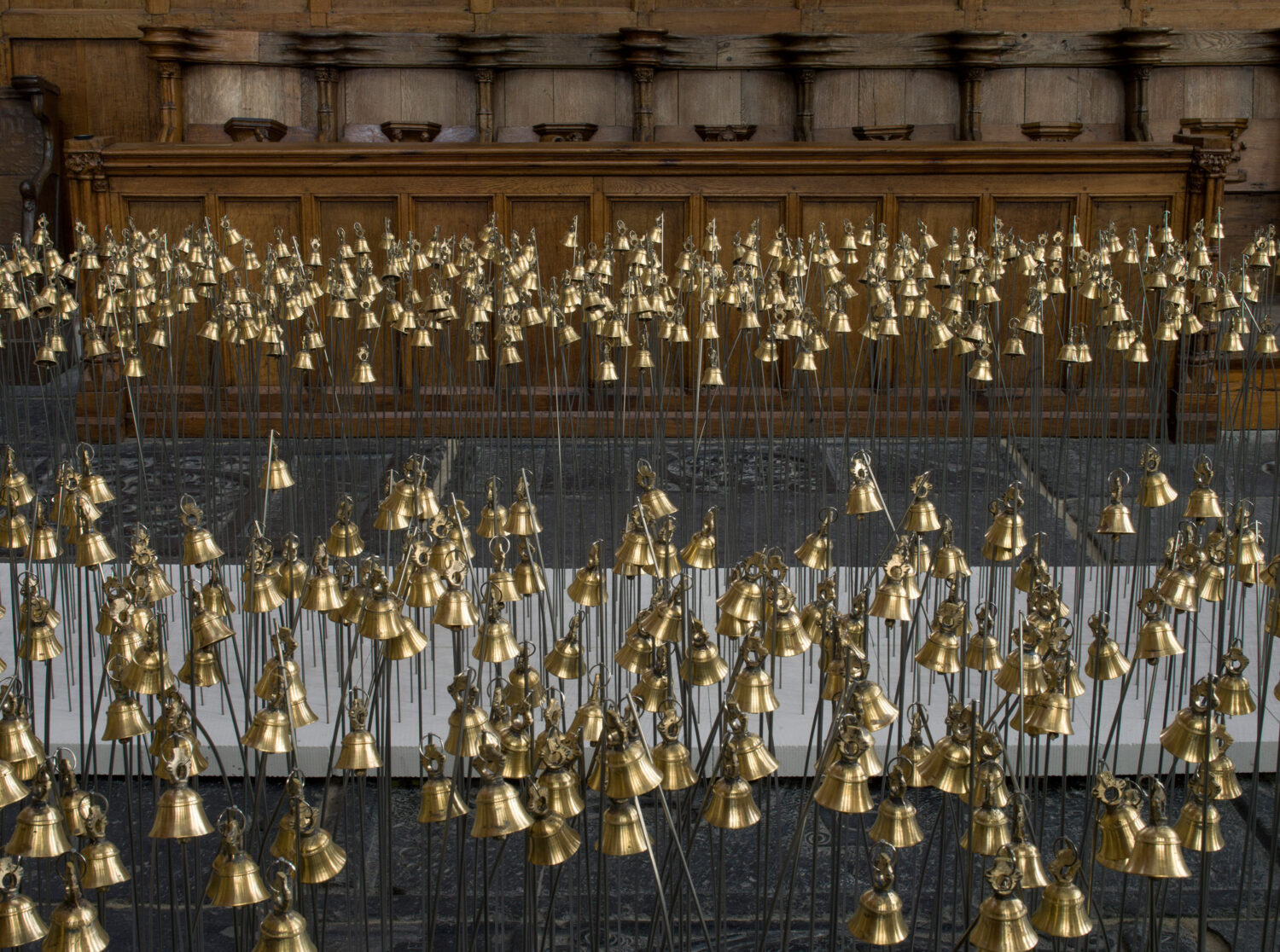Rituals of Care: Antonio Obá at Centre d’Art Contemporain Genève
By Nicolas VamvouklisRituals of Care marks the first mid-career survey in Europe for Brazilian artist Antonio Obá, an exhibition that reclaims historical narratives and delves into themes of spirituality and identity. Curated by Andrea Bellini, the show at the Centre d’Art Contemporain Genève spans two floors, offering a compelling exploration of Obá’s layered practice. Through a seamless blend of mediums, the exhibition reflects on African-Brazilian experiences while addressing the impact of systemic erasure. The result is a deeply cohesive presentation that resonates with care and defiance.
The journey begins with Jardim (2022), a large-scale installation that invites visitors to walk through a ten-meter corridor lined with brass bells. Ringing these bells is both an act of participation and an unsettling revelation of one’s presence. The sound, resonating like an alert, transforms the space into a charged environment where the line between hunter and prey blurs. This duality—invitation versus entrapment—sets a powerful tone for the exhibition, underscoring the tension between vulnerability and strength.

This theme continues in Malungo – rito para uma missa preta (2016), an immersive installation that blends sacred elements with raw materials. At its centre is an altar featuring a golden goblet, a bottle of cachaça, and black candles, framed by walls covered in gold leaf. The shimmering interior contrasts with the sombre floor, littered with statuettes of saints and bits of charcoal. Here, Obá critiques the erasure of Black culture while celebrating its resilience. The space vibrates with a sense of revival, drawing viewers into its intricate interplay of light and shadow.
This interplay is further explored in Obá’s paintings, which populate both floors of the gallery. Rendered in oil on canvas, they feature historical, mythical, and everyday figures captured in dynamic poses. The compositions—often tinged with surrealism—merge divine and pop-cultural imagery, creating a dialogue between the extraordinary and the ordinary. Obá’s figures are not static; they seem to hover in motion, embodying a vitality that transcends the canvas.

Central to Obá’s practice is his depiction of the body. Often using his own as a reference, he celebrates Black and nude forms for their vulnerability and strength. These bodies are reimagined as powerful agents of their own stories, subverting traditional portrayals that have historically marginalised them. Each painting reflects a convergence of personal history, cultural memory, and social critique, reminding us of the enduring power of self-representation.
Recurring motifs like fire, candles, cigarettes, and glowing orbs imbue the paintings with a ritualistic quality. Works such as Angelus (2022), Réquiem (2019), and Fabulação I (2021) juxtapose light and darkness to evoke complex emotional responses. These luminous elements echo the “acts of light” in Emily Dickinson’s poetry, drawing a metaphorical thread between natural phenomena and human consciousness. Light here is both a guide and a symbol of renewal, threading through the exhibition with quiet intensity.

The second floor culminates in Encantado (2024), a new film that embodies the themes of pilgrimage and transformation. The narrative follows a lone figure in a raw cotton tunic as he embarks on a symbolic via crucis, shedding layers of his burden at each stop. His journey ends not in revelation but in dissolution, as he blends with the forest, merging human and natural realms. This poetic unravelling speaks to the essence of care and devotion, where endings become beginnings.
The immersive setting of the screening room enhances the film’s impact. Dried tree leaves cover the floor, their crunch underfoot and earthy aroma enveloping visitors in a sensory experience. This primal connection evokes something beyond the visual—a tactile and olfactory reminder of our ties to the natural world. It’s a moment of grounding, where the noise and scent of the leaves anchor viewers in the present while pointing to the sacredness of the environment.

Throughout the exhibition, Obá weaves together themes of heritage and affection with remarkable cohesion. His ability to confront historical violence while crafting new narratives of hope makes Rituals of Care a timely and transformative experience. In a world grappling with questions of belonging and restoration, the exhibition offers an intimate yet universal reflection on resilience.
Fittingly, this is the final show of the Centre at the Bâtiment d’art contemporain Genève before its four-year renovation, a project led by CCHE Genève and Kuehn Malvezzi. As a farewell to the space, Obá’s exhibition embodies the spirit of transformation that the building itself is about to undergo, leaving an indelible mark on its timeline.
Antonio Obá’s Rituals of Care is more than an exhibition—it’s an invitation to engage with the complexities of identity and history. As bells chime, flames flicker, and leaves rustle underfoot, Obá creates a world where reflection and renewal coexist. In his hands, care becomes both an act of resistance and a path to healing, offering light through even the darkest of times.
Rituals of Care by Antonio Obá is on view at the Centre d’Art Contemporain Genève until 16 February 2025.
Feature image: Antonio Obá, Banhistas no 3 – Espreita, 2020. Courtesy of the artist and Mendes Wood DM, São Paulo, Brussels, Paris, New York. © Antonio Obá. Photo by EstudioEmObra